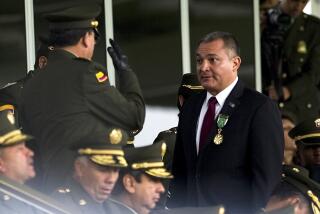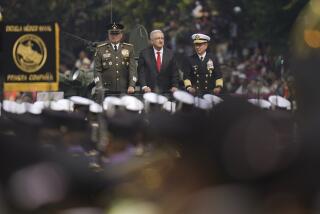With ‘El Chapo’ gone, Mexicans brace for drug cartel turf war
BADIRAGUATO, Mexico — Now that the Mexican government has nabbed the country’s most-wanted drug lord, Fernando Antonio Robles is worried about the future.
Robles is a 16-year-old bricklayer’s apprentice in the wild drug-producing municipality where Joaquin “El Chapo” Guzman grew up. In this hardscrabble patch of mountainous Sinaloa state, more than 74% of the people live in poverty. And yet the tiny county seat is full of fine new, freshly painted houses.
Robles knows that many of them were built by El Chapo’s men.
“A lot of people are going to be unemployed,” Robles said while loitering with a friend on the handsome town square, “because a lot of people worked for him.”
The arrest of Guzman on Saturday in the resort city of Mazatlan, a few hours’ drive and a world away from Badiraguato, was greeted with delight by the Mexican government. President Enrique Peña Nieto is hoping to show the world that he can fight a better war on drugs by relying, as he said Monday, more on “the application of technology and information analysis” than the sheer military muscle deployed by his predecessor, Felipe Calderon.
But many Mexicans are less euphoric about the capture of Guzman. The drug business has long been a main driver of Sinaloa’s economy. Here in the heart of El Chapo’s worldwide empire, many see him as a sympathetic character whose operation pumped billions of dollars into the state.
“He’s helped a lot of people,” said Jesus Gonzalez, the caretaker of a famous chapel honoring Jesus Malverde, an unofficial “folk saint” for the poor — and for drug dealers. According to legend, Malverde, who died in the early 20th century, was, like Guzman, a bandit who spread his wealth around. Guzman “has given out a lot of money,” said Gonzalez. “He’s built many things.”
The less controversial, but more widely held, opinion is that Guzman’s fall could lead to bloody turf and succession battles while doing little to interrupt the broad market forces that define the worldwide drug market and Mexico’s key role in it.
“The triumph of the Peña government in detaining El Chapo shouldn’t be underestimated,” Leo Zuckermann, a columnist for the Mexico City newspaper Excelsior, wrote Monday. “But the question that should interest us more is whether the arrest will help stop the violence in this country or not. I fear that the answer isn’t promising. In fact, the opposite could happen — that is to say, that there will be an increase in homicides, kidnappings and extortion in the short run.”
A power struggle may ensue within Guzman’s Sinaloa cartel, especially if it is revealed that Ismael “El Mayo” Zambada, Guzman’s top partner, gave him up — as some Mexicans suspect.
Such an internal war could disrupt the earning power of the men who commission those new houses in Badiraguato — and in the process hurt the economic prospects of workers like Robles.
But the Sinaloa cartel may also prove to be an exception to the rule. The largest of Mexico’s drug cartels, it has long been considered one of the most sophisticated and well managed. Some close observers assume that Guzman and other leaders had worked out a succession plan as smooth as Apple’s after the death of Steve Jobs. Guzman and Zambada worked together closely and are not likely to unleash their men against each other, these sources say.
The next generation is primed to pick up where El Chapo left off. Guzman’s “children are poised to take over for him,” said Ismael Bojorquez, editor of Culiacan’s Riodoce newspaper who has studied the Sinaloa cartel extensively. Zambada and the other main Sinaloa cartel leader, Juan Jose Esparragoza, known as “El Azul,” are firmly in control of their factions and do not need to seize Guzman’s portion of the operation, Bojorquez said.
Peña Nieto’s team expressed concern about the fragmentation of leaderless cartels soon after the new president took office in December 2012. Interior Minister Miguel Angel Osorio Chong said that the Calderon administration’s “kingpin strategy” — focusing on the capture or slaying of the nation’s top drug lords — resulted in smaller groups that were “more violent and much more dangerous,” often branching out into extortion, kidnapping and robbery rackets.
Succession battles are also believed to have added to Mexico’s recent violence. The killing of Arturo Beltran Leyva in Cuernavaca in December 2009, for instance, unleashed a bloody power struggle among his lieutenants.
Despite the new government’s criticism of the strategy, however, few expected Peña Nieto to abandon it, particularly since that would mean rebuffing American security officials who often supply intelligence on the whereabouts of the capos. The United States’ ability to track Guzman’s satellite phone use was a key to his arrest.
The future of the cartel was the chief topic of debate Monday among residents of Culiacan, a city of 600,000 people.
The cartel’s influence is all-pervasive here: A well-tended cross covered in balloons is displayed prominently in front of a busy shopping mall, commemorating the 2008 slaying of Guzman’s son Edgar Guzman Lopez. The businesses in the mall are apparently too intimidated to argue with its presence. In the leafy town square, conversations with a stranger are often left to trail off when a speaker thinks a cartel spy might be nearby.
Taxi driver Jesus Luis Caldera, 36, predicted the cartel would weather the loss of Guzman. “It’s going to be the same movie — only with different capos,” said Caldera, who said he used to move cocaine for the cartel until he went to prison for it.
Armando Sanchez, 28, the manager of an electronics company from the state of Guanajuato, was playing curious tourist Sunday afternoon at the Malverde shrine. He worried that Guzman’s death might give rival groups — particularly the bloodthirsty Zetas gang — a chance to muscle their way onto Sinaloa cartel territory.
“We’re going to see a lot of fighting for control,” he said.
Guzman may be locked away, but there is still anxiety that the vast machine that has protected him over the years remains intact. The Culiacan newspaper Noroeste reported Monday that it received threatening phone calls after it contacted Mazatlan’s government offices to inquire about reports that municipal police there had been protecting El Chapo.
Guzman’s 13 years of life on the run had its share of hardships: Mexican officials said he avoided arrest last week at a house in Culiacan by escaping through a series of underground drainage canals.
But he was also apparently intent on creating a semblance of a normal life. On Monday, Osorio Chong said that Guzman was with his wife, a former beauty queen named Emma Coronel, and the couple’s young twin girls, when he was arrested. Osorio Chong said that the wife and children were not detained because “they had absolutely nothing to do with respect to the actions of the criminal.”
In the mountain town of Badiraguato — about 50 miles north of Culiacan along a two-lane road controlled by heavily armed police checking up on who might want to visit there — Joaquin Guzman is still the local boy made good. A store selling pirated CDs was stocked with music singing his praises.
“They want to see him dead, but they can’t,” one tune declared. “The cartel is big, it’s blowing up / I’m proud of Chapo Guzman.”
As word of Guzman’s arrest spread, many locals didn’t buy it at first, preferring to believe it was a complicated ruse on the part of the Americans, said Pedro Perez, 45, a worker at an ice cream store.
Others, like Culiacan resident Rodolfo Albertos, 58, see no conspiracy. When it comes to the drug trade, he said, the forces that will continue to shape it are as clear as day — whether “El Chapo” is around or not.
“This isn’t going to stop,” Albertos said. “Not so long as there are consumers. As long as there are consumers, there’s going to be business.”
Cecilia Sanchez of The Times’ Mexico City bureau contributed to this report.
More to Read
Sign up for Essential California
The most important California stories and recommendations in your inbox every morning.
You may occasionally receive promotional content from the Los Angeles Times.











